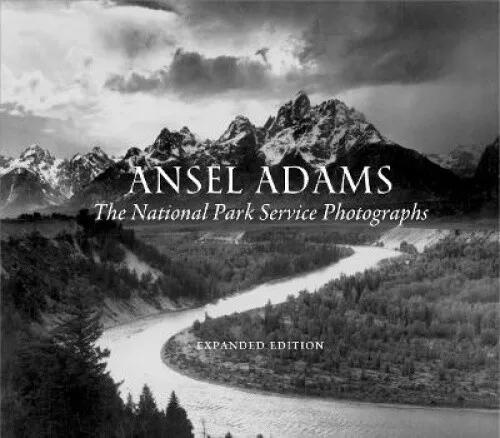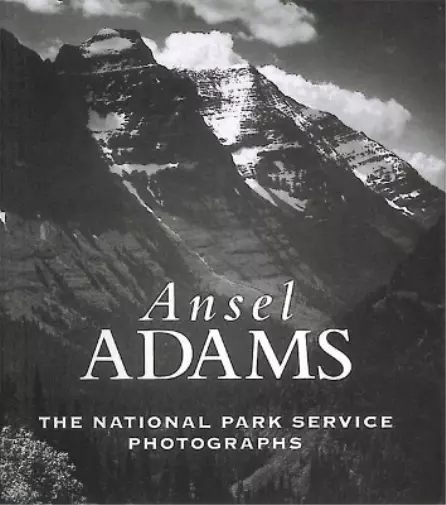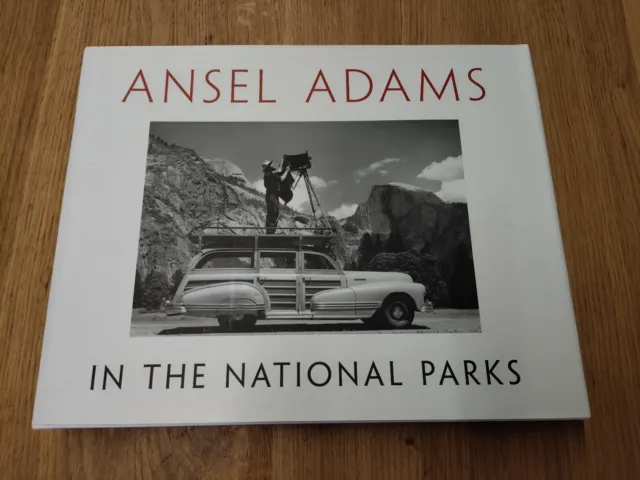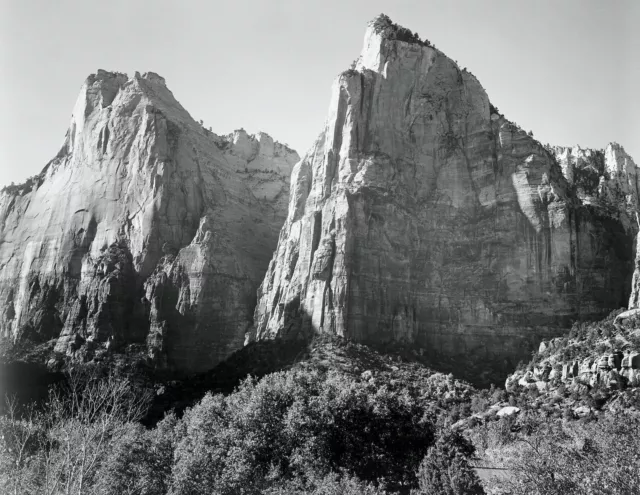Ansel Adams: The National Parks Service Photographs by Ansel Adams (English) Har
Ansel Adams
by
Ansel Adams
In 1941, Ansel Adams photographed America's national parks for a series of murals that would celebrate the country's natural heritage.
FORMAT Hardcover LANGUAGE English CONDITION Brand NewPublisher Description
Ansel Adams was hired by the United States Department of the Interior to photograph America's national parks, producing this group of breathtaking images In 1941, Ansel Adams photographed America's national parks for a series of murals that would celebrate the country's natural heritage. Because of the escalation of World War II, the project was suspended after less than a year, but not before Adams had produced these images, which illustrate both his early innovations and the shape of his later, legendary career as America's foremost landscape photographer. The invitation to photograph the nation's parklands was the perfect assignment for Adams, as it allowed him to express his deepest convictions as artist, conservationist, and citizen. These stunning photographs of the natural geysers and terraces in Yellowstone, the rocks and ravines in the Grand Canyon, the winding rivers and majestic mountains in Glacier and Grand Teton national parks, the mysterious Carlsbad Caverns, the architecture of ancient Indian villages, and many other evocative views of the American West demonstrate the genius of Adams' technical and aesthetic inventiveness. In these glorious, seminal images we see the inspired reverence for the wilderness that has made Ansel Adams' work an enduring influence on environmentalism as well as art. AUTHORS: Ansel Adams (1902-1984) was one of the most prolific and highly acclaimed photographers of the twentieth century, and the author of dozens of publications. He helped establish the department of photography at New York's Museum of Modern Art and founded the Friends of Photography in Carmel, California, and the Center for Creative Photography at the University of Arizona in Tucson. A member of the board of directors of the Sierra Club for thirty-seven years, Adams was instrumental in the growth of the American conservationist movement. Alice Gray is a writer and editor based in Louisville, Kentucky. Her work has appeared in such publications as Art & Auction and ARTnews. Expanded Edition
Author Biography
Ansel Adams (1902–1984) was one of the most prolific and highly acclaimed photographers of the 20th century, and the author of dozens of publications. He helped establish the department of photography at New York's Museum of Modern Art and founded the Friends of Photography in Carmel, California, and the Center for Creative Photography at the University of Arizona in Tucson. A member of the board of directors of the Sierra Club for thirty-seven years, Adams was instrumental in the growth of the American conservationist movement.
Table of Contents
Introduction by Alice GrayKings River Canyon, CaliforniaGrand Canyon National Park, ArizonaNative Americans and their LandZion National Park, UtahSaguaro National Monument, Arizona,Death Valley National Moument, CaliforniaCarlsbad Caverns National Park, New MexicoBoulder Dam, ColoradoRockey Mountain National Park, ColoradoGrand Teton National Park, WyomingYellowstone National Park, WyomingGlacier National Park, MontanaBibliographyIndex
Long Description
In 1941, Ansel Adams photographed America's national parks for a series of murals that would celebrate the country's natural heritage. Because of the escalation of World War II, the project was suspended after less than a year, but not before Adams had produced these images, which illustrate both his early innovations and the shape of his later, legendary career as America's foremost landscape photographer. The invitation to photograph the nation's parklands was the perfect assignment for Adams, as it allowed him to express his deepest convictions as artist, conservationist, and citizen. These stunning photographs of the natural geysers and terraces in Yellowstone, the rocks and ravines in the Grand Canyon, the winding rivers and majestic mountains in Glacier and Grand Teton national parks, the mysterious Carlsbad Caverns, the architecture of ancient Indian villages, and many other evocative views of the American West demonstrate the genius of Adams' technical and aesthetic inventiveness. In these glorious, seminal images we see the inspired reverence for the wilderness that has made Ansel Adams' work an enduring influence on environmentalism as well as art.
Excerpt from Book
Introduction by Alice GrayI am the lover of uncontained and immortal beauty. In the wilderness, I find something more dear and connate than in streets and villages. In the tranquil landscape, and especially in the distant line of the horizon, man beholds something as beautiful as his own nature.-Ralph Waldo Emerson, "Nature"As artist and activist, Ansel Adams (1902-1984) exerted perhaps the greatest single influence on the concept of an ideal American wilderness. Many of the dramatic, evocative photographs of the western American landscape that Adams produced during his lengthy career are now national icons; his poetic vision of nature frames contemporary debates about the intersection of art and environmentalism. Adams would undoubtedly be pleased that his work continues to inspire artists and conservationists alike, although he claimed he had never consciously made an environmentalist photograph.Coming of age in the 1930s, Adams was a man of his time and an adherent of the modernist dictum that a work of art should express, above all, the artist''s feelings about his subject. To that end, he distinguished between assignments "from within"-images he felt compelled to create-and assignments "from without"-the commercial jobs he accepted in order to make a better living. Adams welcomed any opportunity to hone his craft, and so felt that his commercial projects aided in the development of his creative work, although he clearly preferred the latter. He was among the first and firmest believers in photography as a fine art and not merely as a documentary tool.In 1941 Adams was offered an assignment "from without" that directly engaged his inner sensibility, one that not only required technical virtuosity but also called upon his self-expression as artist, conservationist, and citizen: he was asked to photograph the national parks, monuments, Indian lands, and reclamation projects administered by the Department of the Interior. The results, reproduced here, represent a pivotal moment in the artist''s life and work; they illustrate the culmination of his early innovations and the later direction of his celebrated career.The invitation to become photo-muralist for the Interior Department was issued by secretary of the Interior Harold Ickes, who became aware of Adams''s work during the 1930s. By 1941 a number of painters had already been commissioned to paint murals on the walls of the new Interior Department building; no photographers were originally included in the Mural Project (as the undertaking was called) because few people then judged photography to be on a par with painting. Ickes, however, had seen a mural-screen depicting a close-up of leaves and ferns that Adams had exhibited in 1936 and had been so impressed with it that he had purchased it for his office the following year. The secretary had also met Adams in 1936 when the photographer came to Washington to lobby Congress for the creation of a national park in Kings River Canyon, California. Adams had been photographing this region of the Sierra Nevada since the 1920s, and his portfolio of majestic images of this towering, snow-capped mountain range with its tree-lined valleys and clear streams (plates 4-18), dating from the mid-1920s to mid-1930s, swayed a number of public officials. Kings River Canyon was made a national park in 1940, and when Adams signed on as photo-muralist for the Interior Department, he agreed to donate the prints he had shown to the government in 1936 as part of his assignment.The earliest correspondence between Adams and the Interior Department suggests that he was to contribute only a few photographs to the Mural Project. Adams, however, felt that the national parks warranted thorough documentation, and he eventually convinced Ickes to expand his job. Finally, in October 1941, Adams embarked on a photographic journey that would last until the following summer and would take him to California, Arizona, New Mexico, Utah, Colorado, Wyoming, Montana, and Washington; he was paid the highest rate the government then gave to "outside consultants": $22.22 per day plus expenses. It was agreed that Adams would give his prints to the Interior Department but would retain control of the negatives so as to supervise their final printing, and that he would be free to pursue other personal or commercial projects while en route through the West.The mural project was the ideal assignment for Adams in 1941 because it would allow him to express many of his strongest, most defining convictions. The inextricable link between Adams''s art and his favorite subject-the American West-had first been forged in Yosemite National Park in 1916. Fourteen-year-old Ansel arrived in Yosemite on a family vacation away from his San Francisco home armed with his first camera, a Kodak Box Brownie. Amid the dark forests and sweeping mountain skyline, Adams fell in love with the wilderness and with his ability to capture it on film. He would return to Yosemite every year thereafter, eagerly photographing the new world he was discovering through his own eyes and the camera lens.Adams''s formal education ended when he graduated from the eighth grade. An exceptionally bright and active child, he did not thrive in the classroom but undertook his own pursuits with remarkable zeal. In 1915 his father gave him an unlimited pass to the Panama-Pacific Exposition in San Francisco; this was Adams''s classroom, and he was particularly taken with the art galleries and photographic displays. At the time, however, Adams''s primary interest was music, and he continued to train as a concert pianist until 1930, when a fortuitous encounter with the renowned photographer Paul Strand convinced him that photography, rather than music, was his true calling.A prodigiously talented pianist, Adams found similarities between music and photography very early on, and for some time he attempted to pursue both professions. Throughout his life he likened the tonal values in a photograph to musical notes. "The negative is comparable to the composer''s score and the print to its performance," he would say. His photographic career began in earnest in 1919, when he spent the first of many summers working in Yosemite, initially as custodian of the Sierra Club lodge and then as a guide for the Sierra Club''s month-long treks through the parkland. Adams documented these outings and began developing his own aesthetic while photographing Yosemite''s glorious vistas. Ansel found love in Yosemite, too, for it was here that he met and eventually married Virginia Best, whose father ran Best''s Photographic Studio in the park. In 1937 Ansel, Virginia, and their two children moved to Yosemite, having inherited the studio from Virginia''s late father. Although Adams traveled a great deal, and would later settle in Carmel, California, Yosemite National Park remained his spiritual home. It was in Yosemite, marveling at the massive granite face of Half Dome under a moonlit sky or the arabesques of snow-covered tree limbs in the orchard (plate 2), that Adams became convinced of the importance of the wilderness.In the tradition of Walt Whitman and Ralph Waldo Emerson, Adams believed in the spiritually redemptive power of the untouched landscape, feeling that human beings best understand their world and themselves if they see themselves in proportion with, rather than in opposition to, nature. In his numerous letters and articles supporting conservation efforts, Adams consistently identified the "intangible qualities" of the wilderness as those values that must be safeguarded for future generations. He not only promoted the ecological benefits of environmentalism but also stressed that people have a profoundly spiritual need for nature. It was this spiritual connection between the earth and its inhabitants that Adams sought to express in his photographs and that he hoped would convince others of the necessity of preserving national parks. The Mural Project offered Adams the chance to pursue these goals on a greater scale than ever before: by creating wall-size images of the national parks, he would share the beauty of the American land with the public while promoting conservation and exploring new technical and thematic approaches to his art.By the time Adams signed his contract with the Interior Department and headed toward Arizona''s Grand Canyon National Park, 1941 had already been a landmark year for him. On New Year''s Eve, 1940, the first department of photography at a fine-arts institution had opened at the Museum of Modern Art in New York, largely owing to the efforts of Adams, curator and writer Beaumont Newhall, and philanthropist David McAlpin. Back in California, while teaching at the Art Center school in Los Angeles, Adams developed the "Zone System," a revolutionary method of regulating the exposure and development of negatives in order to maximize the photographer''s control of the final printed image. According to the Zone System, light is divided into eleven zones (zero is pure black, medium gray is five, and white is ten).After determining the range of contrast in the subject, the photographer assigns the areas of light and dark in the image to the appropriate zones and then exposes and develops the film according to the desired intensity of tone. This technical innovation, now a staple of photography, facilitated Adams''s aesthetic practice, which he termed "visualization." The basic component of Adams''s "expressive photography," visualization requires the photographer to capture his response to a particular scene, not simply reproduce the landscape before him. The fall of light, the play of shadows, the line of the horizon, the angle of a tree line or rock formation, should all express what the photographer feels about the view. Adams''s visualization was a working method derived from his beloved mentor Alfred Stieglitz''s credo that photographs are the visual equivalents of emotion and perception.
Details
ISBN0789212994
Author
Ansel Adams
Publisher
Abbeville Press Inc.,U.S.
Year
2017
ISBN-10
0789212994
ISBN-13
9780789212993
Format
Hardcover
Imprint
Abbeville Press Inc.,U.S.
Subtitle
The National Parks Service Photographs
Place of Publication
New York
Country of Publication
United States
Pages
160
Media
Book
DEWEY
779.092
Birth
1902
Death
1984
Short Title
Ansel Adams
Language
English
UK Release Date
2017-09-21
Publication Date
2017-09-21
AU Release Date
2017-09-21
NZ Release Date
2017-09-21
US Release Date
2017-09-21
Illustrations
120 Illustrations, color
Audience
General
We've got this
At The Nile, if you're looking for it, we've got it. With fast shipping, low prices, friendly service and well over a million items - you're bound to find what you want, at a price you'll love!
TheNile_Item_ID:146273072;
- Condition: Brand new
- ISBN-13: 9780789212993
- ISBN: 9780789212993
- Publication Year: 2017
- Format: Hardcover
- Language: English
- Book Title: Ansel Adams: the National Park Service Photographs
- Item Height: 229mm
- Author: Ansel Adams
- Publisher: Abbeville Press Inc.,U.S.
- Item Width: 260mm
- Number of Pages: 160 Pages
PicClick Insights - Ansel Adams: The National Parks Service Photographs by Ansel Adams (English) Har PicClick Exclusive
- Popularity - 0 watchers, 0.0 new watchers per day, 13 days for sale on eBay. 0 sold, 3 available.
- Best Price -
- Seller - 1,209,953+ items sold. 1.8% negative feedback. Great seller with very good positive feedback and over 50 ratings.
People Also Loved PicClick Exclusive

Ansel Adams Ansel Adams (Hardback)
$55.50 Buy It Now 24d 3h
Ansel Adams: The National Parks Service Photographs by Ansel Adams
$60.40 Buy It Now 26d 7h
Ansel Adams: The National Parks Service Photographs by Ansel Adams
$60.40 Buy It Now 24d 21h
Ansel Adams: The National Park Service ..., Ansel Adams
$29.95 Buy It Now 20d 21h
Ansel Adams Ansel Adams (Hardback) Tiny Folio
$30.60 Buy It Now 6d 0h 1 watcher
1 watcherAnsel Adams: The National Parks Service Photographs by Alice Gray
$33.55 Buy It Now
Ansel Adams: The National Parks Service Photographs by Alice Gray (English) Hard
$35.87 Buy It Now 3 watchers
3 watchersAnsel Adams in the National Parks: Photographs from America's Wild Places
$45.00 Buy It Now or Best Offer 6 watchers
6 watchersZION NATIONAL PARK, UTAH By Ansel Adams Giclee Fine Art Repro 18.5x24
$102.12 Buy It Now
